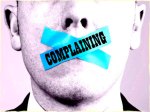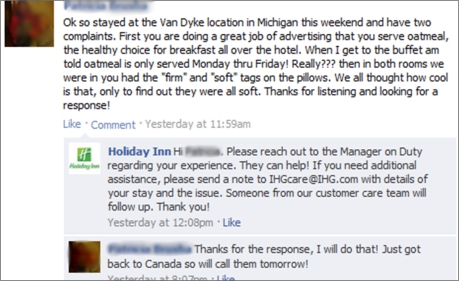By Todd Bacile | May 23, 2012
 I recently interviewed several social media marketers in conjunction with a study being conducted with Florida State University’s marketing department. During these interviews the majority of marketers stated that they have deleted consumers’ negative comments from their firm’s Facebook wall. Mind you, the consumer comments that these marketers deleted did not contain any inappropriate or vulgar language (usually). Moreover, the marketers acknowledged that the consumers were right to justify their complaints related to some type of dis-satisfaction or service failure with their firm. However, the marketers wanted to maintain a clean Facebook wall without any negative comments. The remarks from one marketer summed up the group’s outlook of Facebook comments: “This is our firm’s Facebook page, not a blog. If a consumer wants to complain about something, they should find a blog. It’s my page, so I can control whatever content I want.” I recently interviewed several social media marketers in conjunction with a study being conducted with Florida State University’s marketing department. During these interviews the majority of marketers stated that they have deleted consumers’ negative comments from their firm’s Facebook wall. Mind you, the consumer comments that these marketers deleted did not contain any inappropriate or vulgar language (usually). Moreover, the marketers acknowledged that the consumers were right to justify their complaints related to some type of dis-satisfaction or service failure with their firm. However, the marketers wanted to maintain a clean Facebook wall without any negative comments. The remarks from one marketer summed up the group’s outlook of Facebook comments: “This is our firm’s Facebook page, not a blog. If a consumer wants to complain about something, they should find a blog. It’s my page, so I can control whatever content I want.”
Social Complaining: deleting comments is not the answerAlong with all the positive outcomes that firms associate with social media, one of the “dark” sides of such media is negative publicity. Firms don’t like to discuss this negativity in great detail. As illustrated by the marketers interviewed, they can simply make the problem disappear from their page with a press of the delete button. Some marketers view this situation similar to sweeping dust under a rug: out of sight, out of mind. Newsflash to firms: this does not solve the problem. Social media has created a phenomenon that I refer to as social complaining. The Internet has enabled consumers to complain or post negative comments for several years. However, the power of social media tools to easily reach consumers’ personal social networks is now enabling social complainers to be heard by large masses. Most consumers on Facebook have 100-200 friends. These friends actively listen to a communication describing a malicious marketer, who has a heavy finger on the delete button. I conducted several interviews with consumers asking about their experiences and reactions to having their social media complaints deleted from a company’s Facebook wall. The consumers’ frustration and emotions were immediately apparent. Several of the interviewees stated that they have had their complaints deleted. When this action occurs, this usually sets in motion a series of events that a company A) cannot control; and B) will regret. The consumers stated that the original complaint takes a back-burner to what they now consider an unethical company that does not care about their consumers. These consumers have their own Facebook wall, Twitter accounts, YouTube, blogs, and other easy to use, yet powerful self-publishing tools to inform their networks through social complaining. Not only does the original complaint get re-published to consumers’ personal networks, but also the action that the company took to hide the problem (deleting the comments) becomes a focal point of the communication. Hence, the social complainer is still heard, even though the marketer did their best to sweep the issue under the rug. Advice to CompaniesView a complaint posted to your Facebook wall as an opportunity to stand out and impress your consumers. Not only the original complaining consumer, but also those additional onlookers reading and posting to your wall. When a consumer complains they are asking for you to recognize them and communicate with them. A complaining consumer is really saying: I like your company, spend my hard earned money on your products, and now I need you to help me resolve an issue. Please talk to me! A good way to handle this is to address the consumer in an apologetic and empathetic manner (similar to how traditional brick-and-mortar customer service is conducted). Then, take the complaint offline. I don’t mean delete the complaint from the wall. Rather, ask the consumer to contact you via phone or e-mail to fully resolve the issue. Taking it offline allows for you to give more personal attention to the consumer, while also avoiding any messy details or additional negative comments to be posted for all to see on your wall. A good example of a firm that is using this strategy is Holiday Inn. The screen shots below illustrates their complaint resolution in action. |

Fantastic! I will share this with my class as we just spoke about this as well! It is always an interesting topic for discussion. Great post Todd!
LikeLike
This is an interesting byproduct of firms having a presence within social media. You probably saw the recent statistic that 95% of questions consumers pose to companies on brands’ Facebook pages go unanswered. What we have is a combination of the potential to reach a mass audience via social, but also a public customer service channel available for the masses to see complaint handling by firms.
LikeLike
Pingback: Facebook sponsored results: new possibilities for social complaining « Todd Bacile's Marketing Blog
Pingback: Three examples of consumer generated YouTube video for brands « Todd Bacile's Marketing Blog
Pingback: Social Media Complaints and Dysfunctional Consumers | Todd Bacile's Marketing Blog
Pingback: Todd Bacile's Marketing Blog | Social Media Complaints: An Example of the Tip of the Iceberg Effect
Pingback: Todd Bacile's Marketing Blog | Time: A Business Owner’s Best Weapon Against Negative Yelp Reviews
May I just say what a relief to find somebody that genuinely understands what they’re discussing online.
You definitely understand how to bring a problem to light and make it important.
More people need to check this out and understand
this side of the story. I was surprised that you aren’t more popular
given that you most certainly possess the gift.
LikeLike
These three segments are: The zone of a general speculation most extreme part.
Publisher: Michael Nyleo A religious study is an academic discipline that
requires certain skills to be developed. The firm offering academic writing should be
able to provide revision if the client is not satisfied with the work.
Writing is a skill that is required in many contexts throughout life.
Neonatal nurse practitioner programs include two or more
years of additional study with coursework in advanced assessment, pharmacology, pathophysiology, and clinical hours with a preceptor.
If this could be you, find out more on our websites at Courtesy used cars!
Then determine where and how you want to deal with the opposition. However, an online class gives
higher chances for a teacher to deliver the same curriculum to
many regions at once. Apart from, it should not be ingested in a big quantity,
especially throughout being pregnant. Instead of being perched in a tenured Ivy League
post, I went through graduate school at a public university facing severe cutbacks even before the 2008 meltdown.
LikeLike